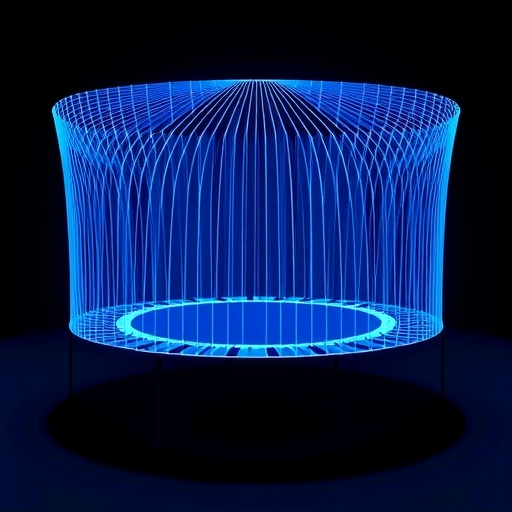In a groundbreaking feat of nanotechnology and quantum physics, researchers have engineered an ultra-thin, perforated membrane that channels vibrational energy—or phonons—with near-perfect efficiency, even around sharp corners. This extraordinary structure, reminiscent of an impossibly delicate trampoline, measures a mere 0.2 millimeters in width and boasts a surface thickness so infinitesimal—just 20 millionths of a millimeter—that it challenges our conventional understanding of material resilience and wave transport at the nanoscale. Far from a playground apparatus, this "trampoline" is a highly specialized waveguide designed to harness phonons, the quantized units of vibrational energy propagating through a crystalline lattice, with unprecedented control and minimal energy loss.
Unlike traditional mechanical waveguides that suffer from scattering and reflection, the trampoline’s patterned surface, perforated with recurring rounded triangular holes organized in a precise lattice, enables phonons to travel with remarkable momentum conservation. What makes this design revolutionary is its topological principles, which allow vibrational energy waves not only to propagate in multiple directions within different regions of the membrane simultaneously but also to navigate sharp 120-degree bends without back-reflection. This phenomenon essentially creates a phononic path that moves "around the corner," opening new horizons for directing sound-based signals through complex geometries.
The physics behind this breakthrough lies in the concept of topological waveguiding—a method inspired by the mathematical field of topology, which studies properties preserved under continuous deformations. Applying these principles to the design of the silicon nitride membrane surface creates robust vibrational pathways that resist imperfections and defects commonly encountered in nanoscale fabrication. The resulting structure channels phonons with loss rates so low that fewer than one in every ten thousand vibrational quanta is reflected backward at corners, a performance metric that rivals the quality standards found in modern telecommunication devices.
Central to this innovation is Professor Oded Zilberberg, a condensed-matter theorist from the University of Konstanz, who conceptualized the trampoline’s intricate design. Zilberberg’s collaborative effort with experimental teams from the University of Copenhagen and ETH Zurich has culminated in a published report in the journal Nature, elucidating how such topological waveguides can be practically realized and exploited. The work convincingly bridges theory with application, demonstrating that ultra-thin membranes engineered at the nanoscale can meaningfully advance phonon transport technology.
The practical implications of these findings are vast, especially for microchip technology, where efficient manipulation of energy and signals is paramount. In conventional electronic circuits, routing signals around tight corners introduces signal degradation and energy loss, impairing overall device performance. By leveraging topological phonon waveguides, it becomes feasible to design integrated circuits capable of channeling vibrational signals precisely and with minimal dissipation, potentially leading to faster, more efficient chips with improved heat management and signal integrity.
This trampoline waveguide leverages silicon nitride, a material prized in nanofabrication for its mechanical strength and compatibility with existing semiconductor processes. The membrane’s ultra-thin nature combined with the engineered periodic pattern introduces a soft clamping effect, which suppresses unwanted vibrational modes while promoting those that enable near-lossless transmission. This soft clamping is key to achieving the low-loss, high-fidelity routing that underpins the trampoline’s remarkable functionality.
Intriguingly, the trampoline’s design includes a "trampoline within the trampoline" at its center, where oscillations exhibit complex motion patterns that move in a perfect triangular loop. This sophisticated internal structure suggests a new kind of phononic mode confinement and routing mechanism that defies previous limitations on waveguide geometry. The ability to guide phonons in such tailored patterns opens avenues for investigating exotic vibrational states and their interaction with quantum systems.
While the trampoline is not designed for human-scale interaction, Zilberberg humorously notes the possibility of creating a larger-scale analog, though cautioning that such an experiment would require safety measures, such as helmets. This playful thought underscores the contrast between the nano-engineered device’s specialized function and the familiar trampoline’s recreational use, highlighting how nature’s smallest scales can inspire new kinds of technological innovation.
The research was supported by a consortium of international funding bodies, including the European Research Council, Novo Nordisk Foundation, Danish National Research Foundation, Swiss National Science Foundation, German Research Foundation, and the EU’s Horizon 2020 program, underscoring the collaborative, multidisciplinary nature of this scientific achievement. The involvement of multiple universities across Germany, Denmark, and Switzerland has facilitated rapid progress from theoretical conception to experimental validation.
Technical experts in condensed matter physics and nanomechanics will recognize the subtle but significant advance this waveguide represents. By integrating topological concepts into phonon transport, the team has opened new methodological paths for controlling heat and sound at scales where quantum and classical effects converge. Such pioneering work has the potential to revolutionize fields ranging from quantum computing to advanced materials engineering.
This next-generation phonon waveguide stands as a testament to how innovation in material science, quantum theory, and applied mathematics can converge to create devices with functionality that rivals—and possibly exceeds—traditional electronic components. As researchers continue to refine these membranes and uncover novel topological configurations, the promise of phonon-based circuitry that operates with minimal loss and maximal precision becomes ever more tangible.
In sum, the ultra-thin silicon nitride trampoline waveguide epitomizes a new paradigm in phonon control, leveraging topology to bend vibrational energy around corners with astonishing efficiency. It heralds a future where phononic circuits may integrate seamlessly with existing technologies, offering robust signal transport that diminishes energy loss and enhances performance in a variety of nano- and microscale applications.
Subject of Research: Control and routing of phonon transport using topologically engineered silicon nitride membranes
Article Title: A soft-clamped topological waveguide for phonons
News Publication Date: 2025
Web References: http://dx.doi.org/10.1038/s41586-025-09092-x
References:
Xi, X., Chernobrovkin, I., Košata, J., Zilberberg, O., Schliesser, A. et al. A soft-clamped topological waveguide for phonons. Nature (2025).
Image Credits: Xiang Xi, Niels Bohr Institute in Copenhagen
Keywords
Physics, Quantum mechanics, Phonon transport, Topological waveguides, Silicon nitride, Nanomechanics, Quantum materials, Microchip circuits




